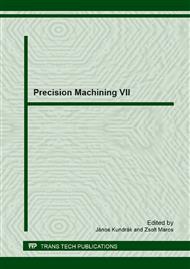[1]
Š. Horváth, E. Hrušková, and A. Mudriková, Areas in flexible manufacturing-assembly cell, Ann. Fac. Eng. Hunedoara – J. Eng., vol. VI, no. 3, (2008).
Google Scholar
[2]
G. Varga and I. Dudás, 3D Topography for Drilled Surfaces, Key Eng. Mater., vol. 381–382, p.225–228, Jun. (2008).
DOI: 10.4028/www.scientific.net/kem.381-382.225
Google Scholar
[3]
G. Varga and J. Kundrák, Effect of Environmentally Conscious Machining on Machined Surface Quality, Appl. Mech. Mater., vol. 309, p.35–42, Feb. (2013).
DOI: 10.4028/www.scientific.net/amm.309.35
Google Scholar
[4]
G. Varga and I. Dudas, Modelling and examinations of dry machining processes, in Proceedings of the IASTED International Conference on Modelling, Simulation, and Optimization, Kauai, HI, 2004, p.327–331.
Google Scholar
[5]
M. Matúšová and E. Hrušková, Basic design of the proposed manufacturing system, Mach. Des., p.217–220, (2010).
Google Scholar
[6]
A. Mudriková and D. Cagáňová, Educational process improvement in virtual laboratory via e-learning., in XXIV. International Scientific Conference, Miskolc, 2010, p.19–25.
Google Scholar
[7]
P. Košťál and K. Velíšek, Flexible manufacturing system., World Acad. Sci. Eng. Technol., vol. 77, p.825–829, (2011).
Google Scholar
[8]
E. Hrušková, K. Velíšek, and M. Charbulová, Assembly cell design supported by computer., in VI Conferencia Cientifica Internacional de Ingeniería Mecánica., Villa Clara, Cuba, (2010).
Google Scholar
[9]
E. Hruskova, R. Holubek, and K. Velisek, The possibilities of increasing the flexibility of inteligent assembly cell, in PROCEEDINGS OF THE ASME 10TH BIENNIAL CONFERENCE ON ENGINEERING SYSTEMS DESIGN AND ANALYSIS, 2010, VOL 4, THREE PARK AVENUE, NEW YORK, NY 10016-5990 USA, 2010, p.651.
DOI: 10.1115/esda2010-24460
Google Scholar
[10]
R. Ruzarovsky, S. Horvath, and K. Velisek, Designing of automated manufacturing and assembly systems, in ANNALS OF DAAAM FOR 2008 & PROCEEDINGS OF THE 19TH INTERNATIONAL DAAAM SYMPOSIUM, VIENNA UNIV TECHNOLOGY, KARLSPLATZ 13, WIEN, A-1040, AUSTRIA, 2008, p.1201.
Google Scholar
[11]
G. . Bohács and K. F. . Semrau, Automatic visual data collection in material flow systems and the application to simulation models [Automatische visuelle datensammlung aus materialflusssystemen und ihre anwendung in simulationsmodellen], Logist. J., vol. 2012, p.1–7, (2012).
DOI: 10.2195/lj_notrev_bohacs_de_2012_01
Google Scholar


